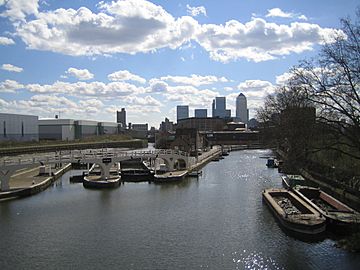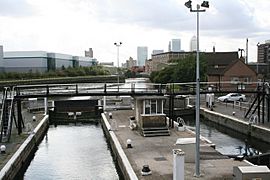Bow Locks facts for kids

Bow Locks, with Bow Creek, beyond, at low tide. Limehouse Cut begins to the right of the locks.
|
|
| Waterway | River Lee Navigation |
|---|---|
| County | Tower Hamlets Greater London |
| Maintained by | Canal & River Trust |
| Operation | Mechanical |
| First built | 1850 |
| Latest built | 1930 |
| Length | 95 feet (29.0 m) |
| Width | 19 feet 6 inches (5.94 m) |
| Fall | tidal |
| Distance to Hertford Castle Weir |
28 miles (45.1 km) |
| Coordinates | 51°31′23″N 0°00′29″W / 51.523°N 0.0081°W |
Bow Locks (No20) are a set of special gates for boats. They are in Bromley-by-Bow in Tower Hamlets and Newham. These locks connect the tidal Bow Creek to the River Lee Navigation. The River Lee Navigation is a river that has been made into a canal.
These locks were first built in 1850. They were rebuilt in 1930. This happened when the Prescott Channel was also dug nearby. In the past, at high tide, water from Bow Creek flowed through Bow Locks. This raised the water level in canals like the Limehouse Cut. But in 2000, the locks were changed. Now they keep the tide out. This helps stop mud from building up in the canal system.
Contents
History of Bow Locks
Bow Locks has a very long history. The first mention of a water control structure here was during the time of King Edward I. Henry de Bedyk, who owned nearby mills, built a structure before 1307. Even though people said it should be removed, it stayed.
In 1416, this structure worked like a flash lock. This was a dam with a channel that boats could go through. The channel was about 18 feet (5.5 m) wide. It could be closed with wooden boards to keep water levels high.
Changes Over Time
The mill owners rebuilt the structure in 1573. The City of London checked the plans to make sure boats could still use the river. In 1588, the gates would open by themselves when the tide in Bow Creek was higher. They would close when the tide went down.
But this caused problems. Sometimes the tide was not high enough to open the gates. The lock keeper would not open them because the mills needed the water. In the 1660s, they still used flashboards. After 1713, the bottom of the structure was raised. Two gates were put in. This helped the millers but made it harder for boats.
In 1721, the mill owners lowered the bottom again. This was done after advice from George Succold. The City of London watched over the work.
New Routes and Pound Locks
Boat users and mill owners often disagreed. The river was important for trade. So, in 1765, engineer John Smeaton was asked for ideas. He suggested building a new cut from Bow Locks to Limehouse. This would be a better way to the Thames than through Bow Creek. He also suggested changing flash locks into pound locks.
The Limehouse Cut was built and opened in 1777. But the lock at Bow Locks was not changed yet.
A pound lock was finally built between 1851 and 1852. It was big enough for barges up to 108 by 20 feet (32.9 by 6.1 m). Using the river was free up to Old Ford lock. But the people in charge charged a fee to use the new Bow Locks. Boat users did not like this.
They reached a deal: using the lock cost money. But using the nearby flood gates was free. These gates could only be used at certain tide levels. This practice of free passage through the gates continued.
Modern Updates
The lock was rebuilt in 1900. Its length was made shorter, to 93.5 feet (28.5 m). A second lock of the same size was built next to it in 1931.
Very high tides used to flow over the lock. This flooded the Limehouse Cut until 2000. Then, a flood wall and a second set of gates were added. Now, the lock can be used at all tide levels. It also stops flooding. The London Waterway Partnership paid for this project.
In 2004–05, British Waterways fixed the old footbridge over the locks. This bridge was built in the 1930s. It was an early example of using reinforced concrete for a thin design. The work included replacing concrete and handrails. They also put a new surface on the walkway. The work cost £3.3 million. Special scaffolding was used so boats could still use the lock during the 6-month repair.
Access and Transport
You can reach Bow Locks by walking or cycling along the towpath. This path is part of the Lea Valley Walk.
The closest London Underground stations are Bromley-by-Bow and West Ham.
Gallery




